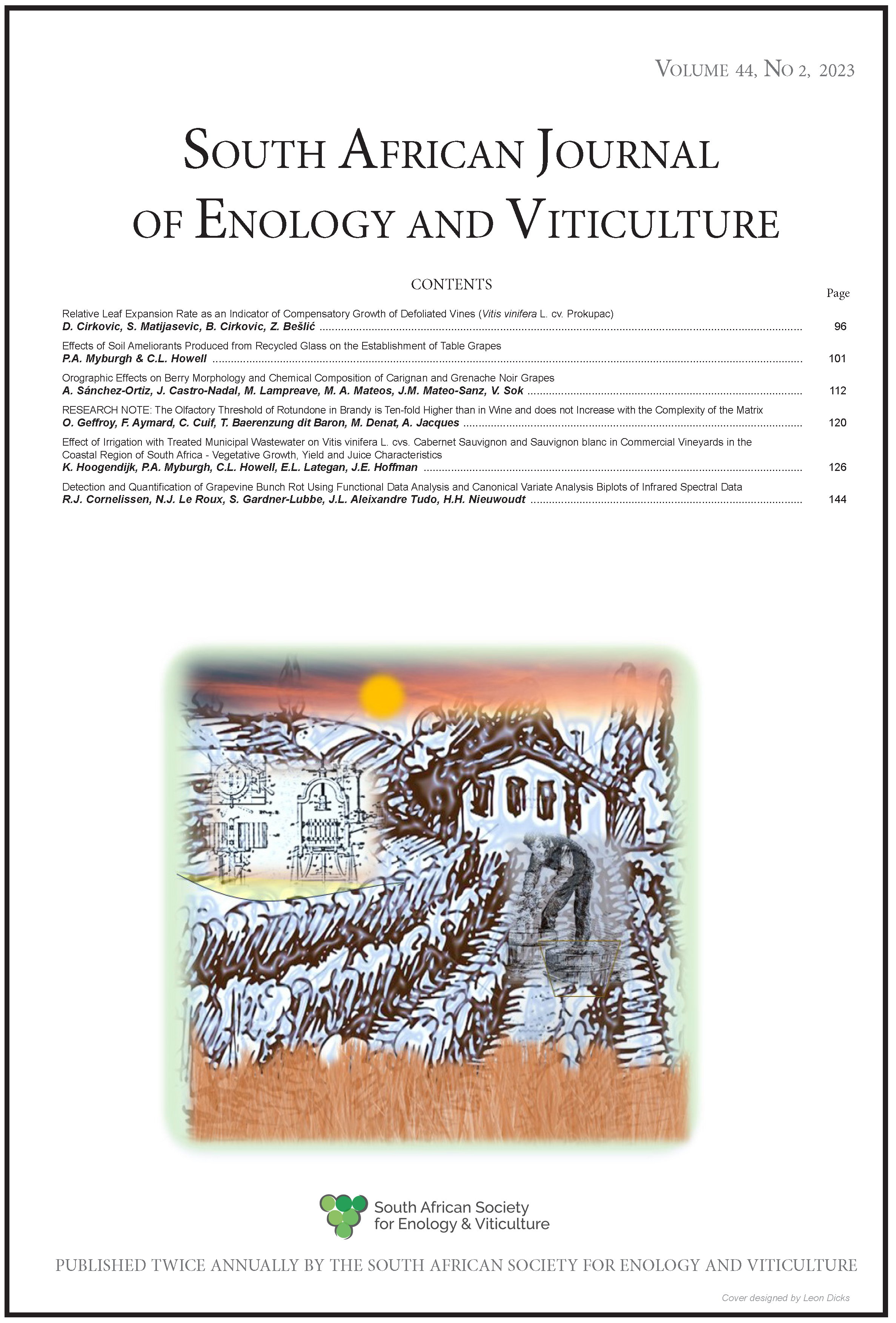Detection and Quantification of Grapevine Bunch Rot Using Functional Data Analysis and Canonical Variate Analysis Biplots of Infrared Spectral Data
DOI:
https://doi.org/10.21548/44-2-5913Abstract
Grapevine bunch rot assessment has economic significance to wineries. Industrial working conditions
require rapid assessment methods to meet the time constraints typically associated with grape intake
at large wineries. Naturally rot-affected and healthy white wine grape bunches were collected over
five vintages (2013 to 2016, 2020). Spectral data of 382 grape must samples were acquired using three
different, but same-type attenuated total reflection mid-infrared (ATR-MIR) ALPHA spectrometers. The
practical industrial problem of wavenumber shifts collected with different spectrometers was overcome by
applying functional data analysis (FDA). FDA improved the data quality and boosted data mining efforts
in the sample set. Canonical variate analysis (CVA) biplots were employed to visualise the detection and
quantification of rot. When adding 90 % alpha-bags to CVA biplots minimal overlap between rot-affected
(Yes) and healthy (No) samples was observed. Several bands were observed in the region 1734 cm-1 to 1722
cm-1 which correlated with the separation between rot-affected and healthy grape musts. These bands
connect to the C=O stretching of the functional groups of carboxylic acids. In addition, wavenumber 1041
cm-1, presenting the functional group of ethanol, contributed to the separation between categories (severity
% range). ATR-MIR could provide a sustainable alternative for rapid and automated rot assessment.
However, qualitative severity quantification of rot was limited to only discriminating between healthy and
severe rot (> 40 %). This study is novel in applying FDA to correct wavenumber shifts in ATR-MIR spectral
data. Furthermore, visualisation of the viticultural data set using CVA biplots is a novel application of this
technique.
Downloads
Downloads
Published
Issue
Section
License
A copyright form will be e-mailed to the corresponding author when the manuscript has been accepted for publication.
In principle, the Author agrees to the following when he/she signes the copyright agreement:
I hereby assign to the SOUTH AFRICAN SOCIETY FOR ENOLOGY AND VITICULTURE (SASEV) the copyright of the text, tables, figures, supplementary material, illustrations and other information (the Material) submitted with the manuscript to be published in SOUTH AFRICAN JOURNAL OF ENOLOGY AND VITICULTURE (SAJEV) (the "Article"). The copyright becomes effective from the date the Article has been accepted for publication in SAJEV.
This is an open access journal, and the authors and journal should be properly acknowledged, when works are cited.
Author's may use the publishers version for teaching purposes, in books, theses, dissertations, conferences and conference papers.
A copy of the authors' publishers version may also be hosted on the following websites:
- Non-commercial personal webpage or blog.
- Institutional webpage.
- Authors Institutional Repository.
The following notice should accompany such a posting on the website: This is an electronic version of an article published in SAJEV, Volume XXX, number XXX, pages XXX - XXX, DOI. Authors should also supply a hyperlink to the original paper or indicate where the original paper (www.journals.ac.za/index.php/sajev/) may be found.
Authors publishers version, affiliated with the Stellenbosch University will be automatically deposited in the University's Institutional Repository SUNScholar.
Articles as a whole, may not be re-published with another journal.
The following license applies:
Attribution CC BY-NC-ND 4.0

